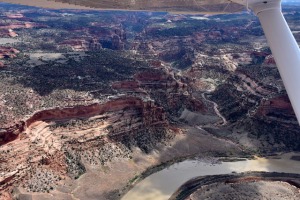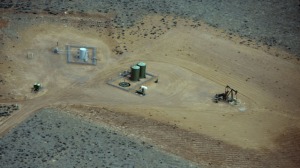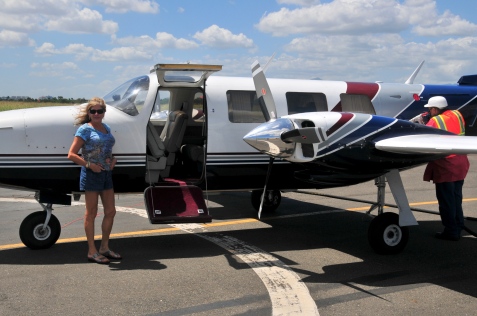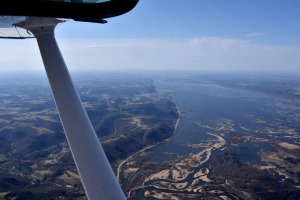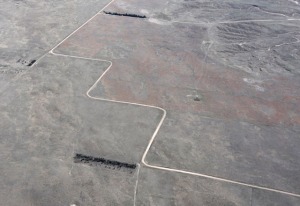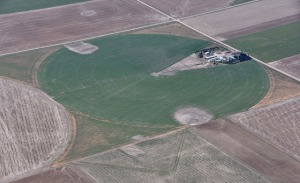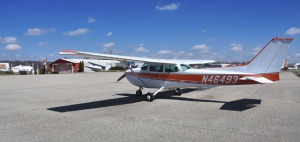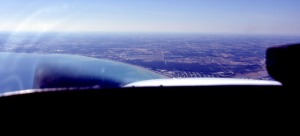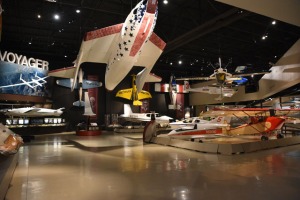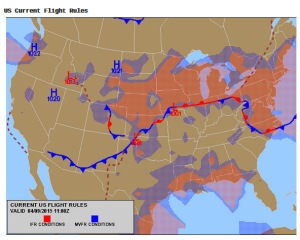After a long – and sometimes frustrating – day, we’ve made it to Florida.
The weather this morning in Texarkana was beautiful, and the forecast was for the rain which was over north Florida and Georgia to have moved offshore by the time we arrived late in the day. So, with our fingers crossed, we took off from KTXK bright and early.
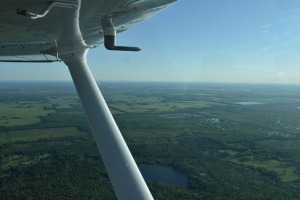
This is the Red River in Arkansas – the cut-off oxbow bend is now called “Cypress City Lake”.

I’m not sure what’s going on here. Looks like static electricity on a grand scale…
After an hour or so, we crossed the Mississippi – unlike my first crossing last week, the River was in full Big Muddy mode, complete with towboats. 
This is a tributary of the Mississippi, with farms on each bank. 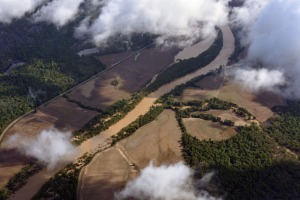
I’d seen a post on the AOPA Members facebook group from the FBO at Monroe County, Alabama (KMVC), inviting people flying to Sun’n’Fun to stop in for a free buffet meal. As it turned out, KMVC was almost exactly half way between Texarkana and Clearwater, so it made a perfect stop for fuel and food. About three hours after taking off, we were on final for runway 21, KMVC.

Everyone at Monroe County was as friendly as can be – the guy on the line even pumped our fuel at the self-service fuel pump. We fueled next to another airplane (a Cherokee) headed to Sun’n’Fun, then we all went into the FBO for food.
It was still a bit early for lunch, so they had a breakfast buffet – sausages, corn bread, grits (of course), sausage-and-egg-biscuits, coffee and other drinks, even popcorn… 
We filled up, then sat around talking flying while we watched the weather on our tablets or smartphones – the storms moving in from the Gulf of Mexico hadn’t moved on as predicted. In fact, they seemed to be getting worse. We waited, and watched, until it looked like there was a route along the back side, if we headed more directly south and then east. The problem is that most of the Gulf coast around there, and many miles inland, are all restricted areas and military operations areas (MOA’s). We found that we could take a corridor from KMVC to Logan (1A4), Tri County (1J0), and Mariana (KMAI), then south to Talahassee (KTLH) which avoids the various airspaces. We decided to go ahead for an hour, which would take us to KMAI, and see how things looked. If the weather wasn’t good ahead, we’d land there. If not, we’d go on to Talahassee and see how it was there, and so on.
As it turned out, we started to get light rain around Talahassee, but the visibility was still good, so we decided to press onward to Perry-Foley (40J). About ten miles from 40J the ceiling began to drop and the rain strengthened. We decided to land and wait it out – along with about eight other airplanes, as it turned out. 
Perry-Foley is another very friendly FBO, with a nice airport dog and a good facility for just sitting around in. So we did, for several hours. I read some magazines, petted the dog, talked flying, checked the weather, autographed the Sun’n’Fun poster on the wall… Finally, a little after 5:00 the weather broke and we got back in the air.
The route to Clearwater runs along the Gulf Coast. The weather wasn’t bad as we went along, and you could see clearing to the west.

To the east, most of the land is pine scrub or mud flats with interesting channels. 
As we neared Clearwater, it turned out that the storms had moved on – but they’d left behind a low deck of broken clouds at about 800-1,200 feet. We threaded our way through the clouds and the busy workspace (talking to Tampa Approach along the way), until we arrived at KCLW – and for a miracle, the deck broke enough to make our landing uneventful at last.

For an extra eight dollars a night, they offered an open-sided hangar for 493, which I decided was worth it. The Cessna’s done a fine job, and earned a week in the shade.
We’re off to Sun’n’Fun tomorrow morning, and all week. If everything works well with the weather (and when does that happen?) we will be back in the air a week from today. As ever, watch this space…
<- Back to Day 5: Santa Fe to Texarkana | Ahead to Sun’n Fun Report ->














